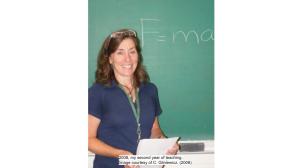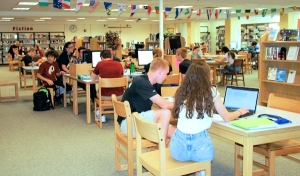Here is a link to my vision statement on my Final Project Page.
Vision Statement for High School Science Physics, Earth Science: Active Engagement and Responsibility Caroline Cooney, ET Tech 541-4202, Boise State University, summer 2015
Hands-on, Minds-on, Messy, Collaborating, Learning, Active, Questioning, Responsibility
What do these words all have in common? These are the words that come to
mind when I picture a science classroom that seamlessly integrates technology into the fabric of the class. The goal of integrating educational technology into my high school science classroom is to have students actively engaging with  curriculum and taking ownership for their learning by exploring content, designing investigations to reinforce concepts, solving problems (& making mistakes), learning from those mistakes, and sharing knowledge with peers and instructors, all while utilizing technology as part of the process. “When technology integration in the classroom is seamless and thoughtful, students not only become more engaged, they begin to take more control over their own learning, too.” (Edutopia, 2007a). In my opinion, learning can be messy and difficult at times, but when students take responsibility and integrate all of the aforementioned pieces together, that is when true learning occurs!
curriculum and taking ownership for their learning by exploring content, designing investigations to reinforce concepts, solving problems (& making mistakes), learning from those mistakes, and sharing knowledge with peers and instructors, all while utilizing technology as part of the process. “When technology integration in the classroom is seamless and thoughtful, students not only become more engaged, they begin to take more control over their own learning, too.” (Edutopia, 2007a). In my opinion, learning can be messy and difficult at times, but when students take responsibility and integrate all of the aforementioned pieces together, that is when true learning occurs!
The “big idea” for the vision of my science classroom is one of active engagement

2015, My Class using the Media Center to solve Physics Problems. Courtesy of D. Redding (2015).
and responsibility with science content, technology, each other, teachers, and the school community. In part, the big idea comes from the Mansfield High School’s core values and expectations, which are the Mansfield High School student
- communicates effectively,
- analyzes information from text and other media sources,
- accesses information from text and other media sources,
- solves problems and creates solutions using curiosity, imagination, and critical thinking skills,
- uses technology effectively,
- collaborates with others to a productive end,
- leads by influence and example, and
- demonstrates personal and global responsibility.
As a high school teacher, my job is not only to help my students learn about Earth Science and Physics concepts/problem solving, but also to ignite a journey of lifelong learning. “Effective tech integration must happen across the curriculum in ways that research shows deepen and enhance the learning process. In particular, it must support four key components of learning: active engagement, participation in groups, frequent interaction and feedback, and connection to real-world experts.” ( Edutopia, 2007b). The jobs of tomorrow do not exist today, but as a teacher it is my duty to ensure that my students have the ability to think, solve problems, work and collaborate with others, and utilize technology to develop answers. These skills will be required of the next generation of workers.
Some potential hurdles that I face as I integrate technology into the classroom include: access to appropriate technology tools, access to internet, evolving teacher ideas of education, and student resistance to constructivist learning. Currently my classroom has a set of eight laptops ( I have access to additional laptops on a cart to make a complete class set), and the school media center has desktops, and a set of Chromebooks available. The laptops sometimes have issues with batteries and connecting to the internet; however the laptops are necessary as the Physics software from Pasco called Capstone runs only on laptops (or desktops). In terms of evolving teacher ideas, in order to integrate technology, the teacher must be willing to make changes to classroom structure and assessments. According to Edutopia, “The first step in successful tech integration is recognizing the change that may need to happen inside of yourself and in your approach to teaching. When any teacher brings technology into the classroom, he or she will no longer be the center of attention…However, this does not mean that the teacher is no longer essential to the learning process… Most students still need a guide to help them use digital tools effectively for learning and collaboration” (Edutopia, 2007a). Lastly, students also need to have evolving expectations of learning . So many times I hear my students say “just tell me what I need to know!” Learning can be challenging for students especially when we ask the students to create their own meaning. I have heard from both students and parents that “the teacher doesn’t teach anymore”, and “I/my child has to figure it out”, but the student and parent eventually see the real learning. My students comment at the end of the trimester that “sometimes the work we do is hard, but really helps us to learn”. The idea is for teachers to guide students as they make meaningful connections with content and technology, so that the student ultimately has a deep understanding of both content and 21st century skills, as well as a sense of responsibility for their own learning.
Technology integration in the science classroom stems from both the Directed Integration Model and the Constructivist Integration Model. The Directed model is based on the objectivist viewpoint that knowledge exists outside of the mind and learning occurs when the knowledge is transmitted to the mind and is able to be retrieved. Conversely, the Constructivist Integration model relies on the view that humans construct knowledge through experience. (Roblyer, p 35). Both models, the Directed Integration and the Constructivist Integration have a place in the technology-integrated science classroom. Some information, such as the basic skills may be best learned using Directed Integration, while higher order thinking skills may best be learned using the Constructivist Integration. I see the classroom as a continuum of these models. I currently am somewhere in the middle, and am probably closer to the Directed Integration model, but as my teaching skills and ideas evolve, I hope to employ more Constructivist Integration model ideas and activities as I progress.
References
Edutopia. (2007a). How to Integrate Technology. In Technology Integration Professional Development Guide. Retrieved from http://www.edutopia.org/technology-integration-guide-implementation
Edutopia. (2007b). Why do we need technology integration?. In Technology Integration Professional Development Guide. Retrieved from http://www.edutopia.org/technology-integration-guide-importance.
Mansfield High School, (n.d.). Retrieved from http://www.mansfieldschools.com/MHS/index.htm
Roblyer, M. D. (2016). Integrating technology into education. (7th ed.). New York, NY, Pearson.
2012 AECT Standard 5 Research: Theoretical Foundations
Below is a Google Presentation of my vision statement.


